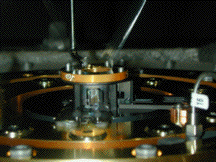Earth-bound ‘star’ impersonates black holes, neutron stars
In an inconspicious, flat-roofed building in Sandia’s Area 4, a machine that creates temperatures rivaling those of the sun is helping physicists examine up-close what happens to iron in the grip of black holes and neutron stars. Experiments on Sandia’s Z machine — the most powerful X-ray generator on Earth — usually focus on the defense of the United States and harnessing nuclear fusion for electrical power.

Download 150dpi JPEG image, ‘Z_pix.jpg’, 1 Mb
But data from recent tests undertaken there by researchers from Lawrence Livermore and Sandia national laboratories should help astronomers trying to interpret images from the billion-dollar Chandra X-ray observatory now orbiting Earth. (Also benefiting will be two billion-dollar X-ray orbiting observatories expected to be sent aloft from Europe and Japan in the next year.)
The results will further understanding of black holes, neutron stars, and the evolution and eventual expiration of the universe, predicts Livermore physicist Mark Foord, one of the leaders of the joint Sandia-Livermore project. The methods developed in the work also can be used in weapons physics, says Sandia project collaborator and physicist Jim Bailey (1677).
Iron is of interest to astronomers because it is among the most complicated of elements widespread in the universe, and therefore among the hardest to understand. Several explanations are possible for the effects it creates in images taken by the recently launched Chandra orbiting telescope.
Being able to ‘cook along’
The problem for astronomers, who now hold bleacher seats to watch titanic energies transform elements on a scale never before seen, is somewhat similar to that faced by apprentice cooks in empty kitchens who watch master chefs cook on TV: Without being able to cook along, many fine points of the observed process can only be guessed at.
Creating a neutron star or black hole on Earth for scientists to understand distant reactions is something of a problem, since there would be no more Earth. But because “neutron stars and black holes emanate X-rays similar in effect to those emanated by Z, we realized we have a chance to test astrophysical theoretical models that have never been tested experimentally,” says Mark.
Says Jim, “We’re looking with spectroscopic eyes at the atomic physics of ionized iron so that these can be compared with theoretical calculations. Astrophysicists will have to consider what implications our figures have for their models.”
“We have a collaboration with four or five groups around the world whose main job is to analyze data from Chandra using their own codes,” says Mark. “They have made some predictions that we’re going to compare to our data.” If necessary, the codes will be modified. The results will be compared with astrophysical calculations embedded in computer codes of how neutron stars affect the widespread element.
Interpreting data from the stars
The experiments proceed by placing square centimeters of iron, a few hundred angstroms thick, close to the Z pinch at the heart of Z. (A Z pinch achieves its output by generating a powerful magnetic field that collides ions at an appreciable fraction of the speed of light.)
This exposes the metal to temperatures of more than one million degrees for a few billionths of a second, ionizing the metal.
“Iron has thousands of spectral lines,” says Mark. “We know their positions [on a spectroscopic scale] but they differ in intensity depending on which electrons, or how many, have been stripped away in the ionizing heat of a neutron star. Calculating these relative intensities is uncertain. This makes it difficult to predict how highly ionized iron is, or should be, in other star systems. If we can measure in the lab what the actual figures are, we learn how to interpret our data from the stars.”
A Sandia instrument that takes seven images temporally, and a Livermore instrument that takes one image in time and provides two images spatially, will help determine effects of the intense X-ray pulse from Z on iron samples in terms of spectrum, temperature, density and ionization.
“Our first two shots were in late September and we are now analyzing the data,” says Mark. “It appears that we were successful at producing highly ionized iron and were able to obtain an accurate measurement of the radiation produced from the Z pinch. We hope to be back in a few months to do follow up experiments and then return again in the summer to explore different regimes. Working with Sandia personnel was a pleasure.” Other collaborators in the experiments are Lawrence Livermore’s Bob Heeter, Bob Thoe, and Jim Emig. Heeter, a recent Princeton graduate and Livermore postdoctoral fellow, is the lead experimentalist for the project. Sandia’s Tom Nash and Gordon Chandler (both 1677), as well as Dan Nielsen, Dan Jobe, and Pat Ryan (all 1673 and K-Tech employees), also contributed.
Lawrence Livermore’s Office of Laboratory Directed Research and Development funds the two-year project.